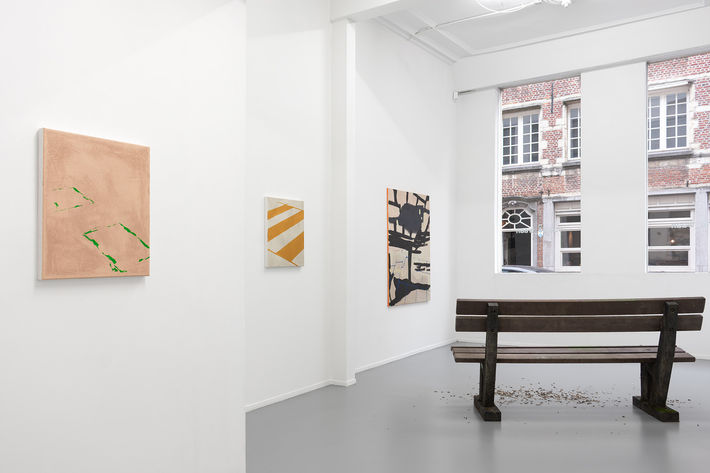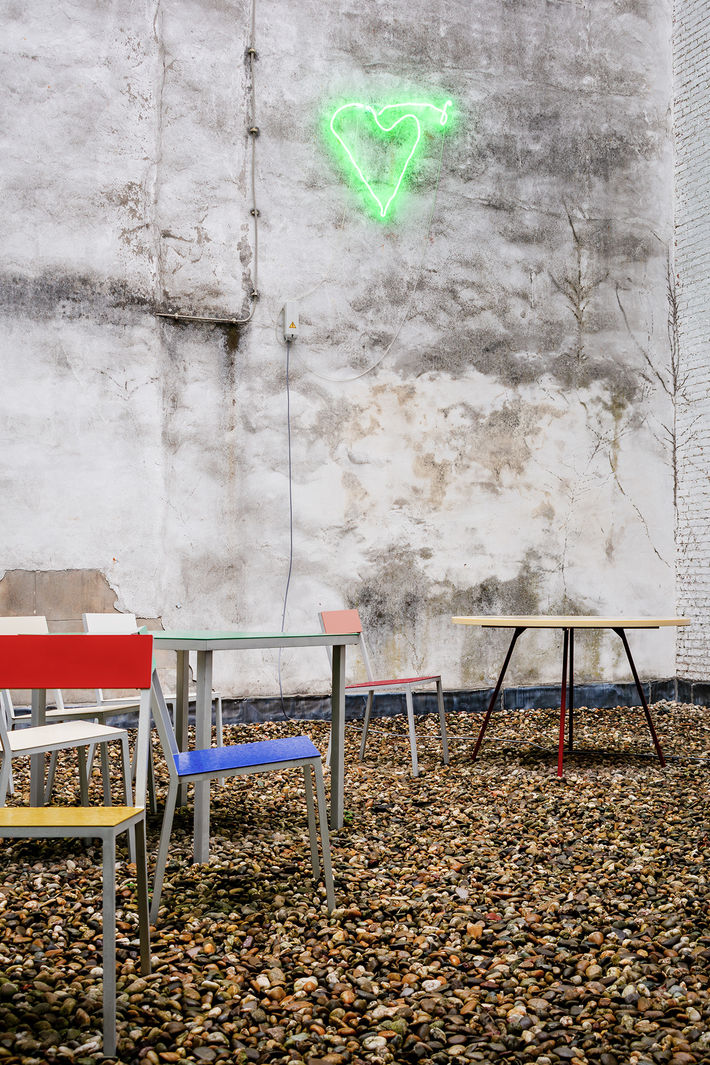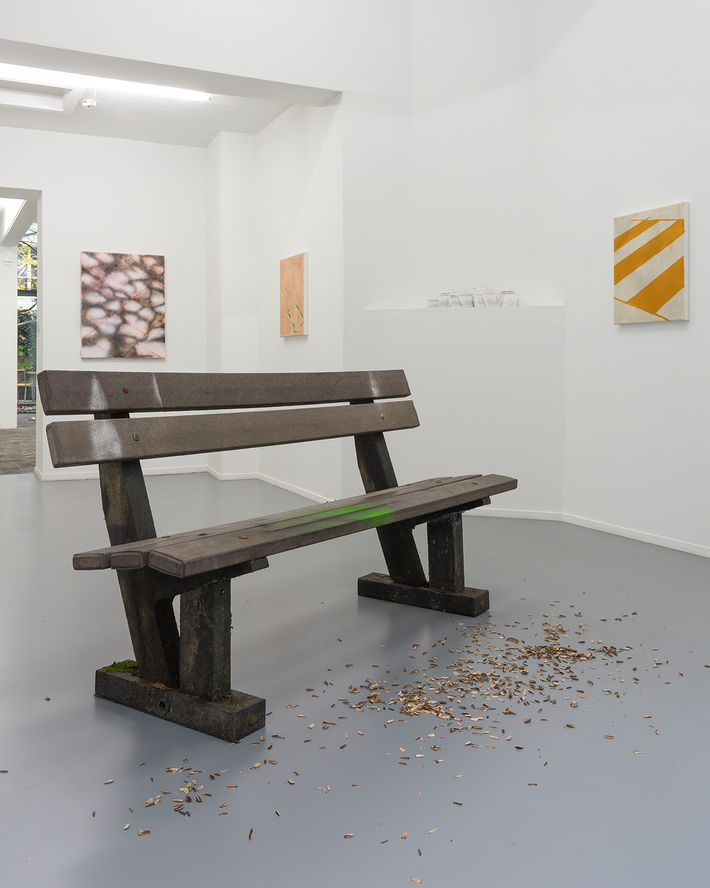82 | Ayrton Eblé
STRAAT
a solo exhibition by Ayrton Eblé
08.11.2025 - 20.12.2025
simultaneously with Susan Collis
Saturday 08.11.25 _ 2 - 7 pm opening drinks in the presence of the artists

pictures by Davide Pastore
AYRTON EBLÉ
STRAAT
For Straat at valerie_traan, I exhibit a collection of new paintings, combined with installations and neon works that have been created as in-situ works over the past three years.
The installation Zwart Zaad (conversation piece) stands as a central element between the paintings. This work was created in 2023 for an exhibition at S.M.A.K., on the occasion of which NICC organised an exhibition for their 25th anniversary. The work consists of a park bench on which the public is invited to eat sunflower seeds and engage in dialogue with one another. The seed shells are left on the floor, creating a trail of this human interaction.
The work functions as a seating object, but also accentuates the installation-like character and themes of my work.
Almost all of the paintings originate from the series of paintings Street, which I started earlier this year. For this, I am working with my archive images for the first time, which I have developed since graduating in 2018, . These are images of mundane and everyday elements of infrastructures surrounding us. By focusing on these elements, I question the power these exert in public space.
Also on display are two neon works that reference graffiti and vandalism. One of these, ‘… was here’, was recently on display at the Doel Festival. Composed of red letters, the text “was here” suggests the presence of something or someone.
‘… was here’ is derived from perhaps the most clichéd, yet enduring slogan in graffiti: the familiar formula ‘[name] was here’, a classic declaration of ‘I existed’.
The ellipsis in the title acts as a textual placeholder, referring to the countless identities that could fill in these characters. By omitting the name and displaying the phrase in neon letters on the façade of a building, the work places itself in an architectural context. It reflects on the ongoing transformation of the built environment, highlighting the transience of both the structure and the viewer.
'Creeping Ivy (ancient graffiti)' shows an image originally found at the archaeological site of Smyrna in present-day İzmir, Turkey. More specifically, the ancient ink drawing was found in the basement of the basilica located in the heart of the Agora and dates back to around 200 AD. The meaning of the image is difficult to ascertain, as research into ancient graffiti has only really gained momentum in the last twenty years. Ascribing a definitive significance to the scribbles of an individual remains a matter of conjecture.
At first glance, the second neon sign appears to form a heart. In reality, the symbolism of the heart originates from the shape of a bunch of grapes. In ancient Greece, the ivy leaf was often associated with Dionysus, the god of wine, ecstasy, fertility, theatre and celebration. Ivy regularly adorned objects used in wedding rituals and thus symbolized love and fertility. As an evergreen climbing plant, ivy was also associated with immortality and fidelity — qualities that stem from its tenacious growth on steep surfaces such as walls and facades, much like graffiti.
AYRTON EBLÉ
STRAAT
Voor Straat bij valerie_traan toon ik een samenstelling van nieuwe schilderijen, gecombineerd met installaties en neonwerken die de afgelopen drie jaar als in-situ-werken zijn ontstaan.
Zo staat de installatie Zwart Zaad (conversation piece) als een centraal element tussen de schilderijen. Dit werk werd in 2023 gemaakt voor een tentoonstelling in het S.M.A.K., waarvoor het NICC een tentoonstelling organiseerde ter gelegenheid van hun 25-jarige jubileum. Het werk bestaat uit een parkbank waarop publiek uitgenodigd wordt om zonnebloempitjes te eten en met elkaar in dialoog te gaan. De omhulsels van de pitjes worden op de grond achtergelaten, waardoor er een spoor ontstaat van deze menselijke interactie ontstaat.
Het werk functioneert als zitobject, maar accentueert ook het installatieve karakter en de thema’s van mijn werk.
De schilderijen komen vrijwel allemaal voort uit de serie schilderijen Straat, waaraan ik eerder dit jaar begon. Hiervoor werk ik voor het eerst met mijn archiefbeelden die ik sinds mijn afstuderen in 2018 heb ontwikkeld. Dit zijn beelden van banale en alledaagse elementen uit infrastructuren om ons heen. Door hier een focus op te leggen, bevraag ik de macht die zij uitoefenen in de publieke ruimte.
Ook zijn er twee neonwerken te zien die refereren aan graffiti en vandalisme. Hiervan was “… was here” recent nog te zien op Doel Festival. Bestaande uit rode letters suggereert de tekst “was here” de aanwezigheid van iets of iemand.
“‘… was here’ ontleent zich aan misschien wel de meest clichématige, maar toch blijvende slogan in graffiti: de bekende formule ‘[naam] was hier’, een klassieke verklaring van ‘ik heb bestaan’.
De weglatingstekens in de titel fungeren als een tekstuele plaatshouder, die verwijst naar de talloze identiteiten die deze tekens zouden kunnen invullen. Door de naam weg te laten en de zin in neonletters op de gevel van een gebouw weer te geven, plaatst het werk zichzelf in een architecturale context. Het reflecteert op de voortdurende transformatie van de gebouwde omgeving, waarbij de vergankelijkheid van zowel structuur als toeschouwer wordt uitgelicht.”
'Creeping Ivy (oude graffiti)' toont een afbeelding die oorspronkelijk te vinden is in de archeologische vindplaats Smyrna in het huidige İzmir, Turkije. Meer specifiek werd de oude inkttekening gevonden in de kelder van de basiliek die in het hart van de Agora ligt en dateert uit ongeveer 200 na Christus. De betekenis van de afbeelding is moeilijk te achterhalen, aangezien het onderzoek naar oude graffiti pas de laatste twintig jaar echt aan vaart heeft gewonnen. Het toekennen van een definitieve betekenis aan de krabbels van een individu blijft een kwestie giswerk.
De tweede neon lijkt op het eerste gezicht een hart te vormen. In werkelijkheid ontleent de symboliek van het hart haar oorsprong aan de vorm van een druiventros. In het oude Griekenland werd het klimopblad vaak geassocieerd met Dionysus, de god van wijn, extase, vruchtbaarheid, theater en feest. Klimop sierde regelmatig voorwerpen die tijdens huwelijksrituelen werden gebruikt en stond zo symbool voor liefde en vruchtbaarheid. Als groenblijvende klimplant werd klimop bovendien geassocieerd met onsterfelijkheid en trouw — eigenschappen die voortkomen uit haar hardnekkige groei op steile oppervlakken zoals muren en gevels, net als graffiti.















